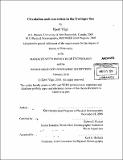| dc.contributor.advisor | Robert S. Pickart. | en_US |
| dc.contributor.author | Våge, Kjetil | en_US |
| dc.contributor.other | Woods Hole Oceanographic Institution. | en_US |
| dc.coverage.spatial | n-gl--- ln----- | en_US |
| dc.date.accessioned | 2010-09-03T18:34:50Z | |
| dc.date.available | 2010-09-03T18:34:50Z | |
| dc.date.copyright | 2010 | en_US |
| dc.date.issued | 2010 | en_US |
| dc.identifier.uri | http://hdl.handle.net/1721.1/58395 | |
| dc.description | Thesis (Ph. D.)--Joint Program in Physical Oceanography (Massachusetts Institute of Technology, Dept. of Earth, Atmospheric, and Planetary Sciences; and the Woods Hole Oceanographic Institution), 2010. | en_US |
| dc.description | Cataloged from PDF version of thesis. | en_US |
| dc.description | Includes bibliographical references (p. 131-149). | en_US |
| dc.description.abstract | Aspects of the circulation and convection in the Irminger Sea are investigated using a variety of in-situ, satellite, and atmospheric reanalysis products. Westerly Greenland tip jet events are intense, small-scale wind phenomena located east of Cape Farewell, and are important to circulation and convection in the Irminger Sea. A climatology of such events was used to investigate their evolution and mechanism of generation. The air parcels constituting the tip jet are shown to have a continental origin, and to exhibit a characteristic deflection and acceleration around southern Greenland. The events are almost invariably accompanied both by a notable coherence of the lower-level tip jet with an overlying upper-level jet stream, and by a surface cyclone located in the lee (east) of Greenland. It is argued that the tip jet arises from the interplay of the synopticscale flow evolution and the perturbing effects of Greenland's topography upon the flow. The Irminger Gyre is a narrow, cyclonic recirculation confined to the southwest Irminger Sea. While the gyre's existence has been previously documented, relatively little is known about its specific features or variability. The mean strength of the gyre's circulation between 1991 and 2007 was 6.8 ± 1.8 Sv. It intensified at a rate of 4.3 Sv per decade over the observed period despite declining atmospheric forcing. Examination of the temporal evolution of the LSW layer thickness across the Irminger Basin suggests that local convection formed LSW during the early 1990s within the Irminger Gyre. In contrast, LSW appeared outside of the gyre in the eastern part of the Irminger Sea with a time lag of 2-3 years, consistent with transit from a remote source in the Labrador Sea. In the winter of 2007-08 deep convection returned to both the Labrador and Irminger seas following years of shallow overturning. The transition to a convective state took place abruptly, without going through a preconditioning phase, which is contrary to general expectations. Changes in the hemispheric air temperature, tracks of storms, flux of freshwater to the Labrador Sea, and distribution of pack ice all conspired to enhance the air-sea heat flux, resulting in the deep overturning. | en_US |
| dc.description.statementofresponsibility | Kjetil Våge. | en_US |
| dc.format.extent | 149 p. | en_US |
| dc.language.iso | eng | en_US |
| dc.publisher | Massachusetts Institute of Technology | en_US |
| dc.rights | M.I.T. theses are protected by
copyright. They may be viewed from this source for any purpose, but
reproduction or distribution in any format is prohibited without written
permission. See provided URL for inquiries about permission. | en_US |
| dc.rights.uri | http://dspace.mit.edu/handle/1721.1/7582 | en_US |
| dc.subject | Joint Program in Physical Oceanography. | en_US |
| dc.subject | Earth, Atmospheric, and Planetary Sciences. | en_US |
| dc.subject | Woods Hole Oceanographic Institution. | en_US |
| dc.subject.lcsh | Hydrography Irminger Sea | en_US |
| dc.subject.lcsh | Ocean circulation Irminger Sea | en_US |
| dc.title | Circulation and convection in the Irminger Sea | en_US |
| dc.type | Thesis | en_US |
| dc.description.degree | Ph.D. | en_US |
| dc.contributor.department | Joint Program in Physical Oceanography | en_US |
| dc.contributor.department | Woods Hole Oceanographic Institution | en_US |
| dc.contributor.department | Massachusetts Institute of Technology. Department of Earth, Atmospheric, and Planetary Sciences | |
| dc.identifier.oclc | 651633095 | en_US |
